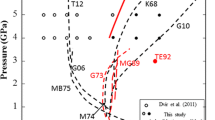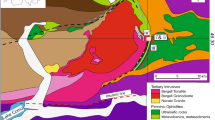Abstract
The 10-Å phase (TAP) is a hydrous magnesium silicate that forms from the reaction of talc with H2O at high pressures. Its high-pressure, low-temperature stability means that it could be a storage site for H2O in subduction zones. We have determined the position of the TAP dehydration reaction, TAP = enstatite + coesite + H2O, in phase-equilibrium experiments from 5.0 to 7.1 GPa. Because previous studies had suggested that the composition of TAP is a function of synthesis duration, we used a TAP sample that was synthesised for 392 h. Over the pressure interval of our experiments, the dehydration reaction is isothermal, occurring at a temperature of ~690°C. It is coincident, within experimental uncertainty, with the position of the dehydration reaction of TAP synthesised in short experiments (up to 46 h). Above 7.5 GPa, TAP breaks down to enstatite + stishovite + H2O. This reaction has a negative dP/dT and terminates at an invariant point involving the 3.65-Å phase at ~9.5 GPa, 500°C. The zero volume change implied by the isothermal reaction TAP = enstatite + coesite + H2O was used to calculate the interlayer H2O content of TAP along the reaction. A best-fit H2O content of 1 H2O pfu was obtained. This H2O content is independent of TAP synthesis conditions, suggesting that variations in previously measured H2O contents of TAP occur during quenching and decompression of the samples. The stability of TAP in the Earth is probably limited to cold subduction zones, but in these, it could persist to 300 km depth.






Similar content being viewed by others
References
Angel RJ, Hugh-Jones DA (1994) Equations of state and thermodynamic properties of enstatite pyroxenes. J Geophys Res 99:19777–19784
Bauer JF, Sclar CB (1981) The “10 Å phase” in the system MgO–SiO2–H2O. Am Mineral 66:576–585
Brodholt JP, Wood BJ (1993) Simulations of the structure and thermodynamic properties of water at high pressures and temperatures. J Geophys Res 98:519–536
Bromiley GD, Pawley AR (2002) The high-pressure stability of Mg-sursassite in a model hydrous peridotite: a possible mechanism for the deep subduction of significant volumes of H2O. Contrib Mineral Petrol 142:714–723
Chinnery NJ (1999) In situ, high pressure-temperature studies of hydrous minerals in subduction zones. Unpublished PhD thesis, University of Manchester, UK
Chinnery NJ, Pawley AR, Clark SM (1999) In situ observation of the formation of 10 Å phase from talc + H2O at mantle pressures and temperatures. Science 286:940–942
Comodi P, Fumagalli P, Nazzareni S, Zanazzi PF (2005) The 10 Å phase: crystal structure from single-crystal X-ray data. Am Mineral 90:1012–1016
Comodi P, Cera F, Dubrovinsky L, Nazzareni S (2006) The high-pressure behaviour of the 10 Å phase: a spectroscopic and diffractometric study up to 42 GPa. Earth Planet Sci Lett 246:444–457
Escartin J, Hirth G, Evans B (2001) Strength of slightly serpentinized peridotites: implications for the tectonics of oceanic lithosphere. Geology 29:1023–1026
Escartin J, Andreani M, Hirth G, Evans B (2008) Relationships between the microstructural evolution and the rheology of talc at elevated pressures and temperatures. Earth Planet Sci Lett 268:463–475
Fumagalli P, Poli S (2005) Experimentally determined phase relations in hydrous peridotites to 6.5 GPa and their consequences on the dynamics of subduction zones. J Petrol 46:555–578
Fumagalli P, Stixrude L (2007) The 10 Å phase at high pressure by first principles calculations and implications for the petrology of subduction zones. Earth Planet Sci Lett 260:212–226
Fumagalli P, Stixrude L, Poli S, Snyder D (2001) The 10 Å phase: a high-pressure expandable sheet silicate stable during subduction of hydrated lithosphere. Earth Planet Sci Lett 186:125–141
Holland TJB, Powell R (1998) An internally consistent thermodynamic data set for phases of petrological interest. J Metam Geol 16:309–343
Hugh-Jones D (1997) Thermal expansion of MgSiO3 and FeSiO3 orth- and clinopyroxenes. Am Mineral 82:689–696
Kudoh Y, Finger LW, Hazen RM, Prewitt CT, Kanzaki M, Veblen DR (1993) Phase E: a high pressure hydrous silicate with unique crystal chemistry. Phys Chem Miner 19:357–360
Levien L, Prewitt CT (1981) High-pressure crystal structure and compressibility of coesite. Am Mineral 66:324–333
Manning CE (1995) Phase-equilibrium controls on SiO2 metasomatism by aqueous fluid in subduction zones: reaction at constant pressure and temperature. Int Geol Rev 37:1074–1093
Pawley AR, Wood BJ (1995) The high-pressure stability of talc and 10 Å phase: potential storage sites for H2O in subduction zones. Am Mineral 80:998–1003
Pawley AR, Welch MD, Smith RI (2004) The 10-Å phase: structural constraints from neutron powder diffraction. Lithos 73:S86
Pawley AR, Welch MD, Lennie AR, Jones RL (2010) Volume behavior of the 10-Å phase at high pressures and temperatures, with implications for H2O content. Am Mineral 95:1671–1678
Phillips BL, Mason HE, Guggenheim S (2007) Hydrogen bonded silanols in the 10 Å phase: evidence from NMR spectroscopy. Am Mineral 92:1474–1485
Prewitt CT, Finger LW (1992) Crystal chemistry of high-pressure hydrous magnesium silicates. In: Syono Y, Manghnani MH (eds) High-pressure research: application to earth and planetary sciences. Terrapub, Tokyo, pp 269–274
Ranero CR, Phipps Morgan J, McIntosh K, Reichert C (2003) Bending-related faulting and mantle serpentinization at the Middle America trench. Nature 425:367–373
Rice SB, Benimoff AI, Sclar CB (1989) “3.65 Å phase” in system MgO–SiO2–H2O at pressures greater than 90 kbars: crystallochemical implications formantle phases. Int Geol Congr Washington DC 2:694–695
Sclar CB, Morzenti SP (1971) High-pressure synthesis and geophysical significance of a new hydrous phase in the system MgO–SiO2–H2O. Geol Soc Am Abstr Prog 3:698
Shinmei T, Tomioka N, Fujino K, Kuroda K, Irifune T (1999) In situ X-ray diffraction study of enstatite up to 12 GPa and 1473 K and equations of state. Am Mineral 84:1588–1594
Skinner BJ (1966) Thermal expansion. In: Clark SP (ed) Handbook of physical constants, vol 97. Geological society of America memoir, pp 75–96
Stalder R, Ulmer P, Thompson AB, Gunther D (2001) High pressure fluids in the system MgO–SiO2–H2O under upper mantle conditions. Contrib Mineral Petrol 140:607–618
van Keken PE, Kiefer B, Peacock SM (2002) High-resolution models of subduction zones: implications for mineral dehydration reactions and the transport of water into the deep mantle. Geochem Geophys Geosyst 3:1056
Wang J, Kalinichev AG, Kirkpatrick RJ (2004) Molecular modeling of the 10-Å phase at subduction zone conditions. Earth Planet Sci Lett 222:517–527
Welch MD, Pawley AR, Ashbrook SE, Mason HE, Phillips BL (2006) Si vacancies in the 10-Å phase. Am Mineral 91:1707–1710
Wilson DS, Teagle DAH, Alt JC, Banerjee NR, Umino S, Miyashita S, Acton GD, Anma R, Barr SR, Belghoul A, Carlut J, Christie DM, Coggon RM, Cooper KM, Cordier C, Crispini L, Durand SR, Einaudi F, Galli L, Gao YJ, Geldmacher J, Gilbert LA, Hayman NW, Herrero-Bervera E, Hirano N, Holter S, Ingle S, Jiang SJ, Kalberkamp U, Kerneklian M, Koepke J, Laverne C, Vasquez HLL, Maclennan J, Morgan S, Neo N, Nichols HJ, Park SH, Reichow MK, Sakuyama T, Sano T, Sandwell R, Scheibner B, Smith-Duque CE, Swift SA, Tartarotti P, Tikku AA, Tominaga M, Veloso EA, Yamasaki T, Yamazaki S, Ziegler C (2006) Drilling to gabbro in intact ocean crust. Science 312:1016–1020
Wunder B, Schreyer W (1992) Metastability of the 10-Å Phase in the system MgO–SiO2–H2O (MSH). What about hydrous MSH phases in subduction zones? J Petrol 33:877–889
Yamamoto K, Akimoto SI (1974) High pressure and high temperature investigations in the system MgO–SiO2–H2O. J Solid State Chem 9:187–195
Yamamoto K, Akimoto S (1977) The system MgO–SiO2–H2O at high pressures and temperatures—stability field for hydroxyl-chondrodite, hydroxyl-clinohumite and 10 Å-phase. Am J Sci 277:288–312
Zanazzi PF, Comodi P, Nazzareni S, Rotiroti N, van Smaalen S (2007) Behavior of 10-angstrom phase at low temperatures. Phys Chem Miner 34:23–29
Zhang ZG, Duan ZH (2005) Prediction of the PVT properties of water over wide range of temperatures and pressures from molecular dynamics simulation. Phys Earth Planet Int 149:335–354
Acknowledgments
ARP acknowledges support from NERC grant NE/D007194/1 and funding from the NERC Envirosync project. NJC acknowledges support from a NERC studentship. SMC would like to acknowledge the support of EPSRC, Daresbury Laboratory. We thank John Waters and John Charnock for help with SEM and EMPA.
Author information
Authors and Affiliations
Corresponding author
Additional information
Communicated by Max W. Schmidt.
Rights and permissions
About this article
Cite this article
Pawley, A.R., Chinnery, N.J., Clark, S.M. et al. Experimental study of the dehydration of 10-Å phase, with implications for its H2O content and stability in subducted lithosphere. Contrib Mineral Petrol 162, 1279–1289 (2011). https://doi.org/10.1007/s00410-011-0653-0
Received:
Accepted:
Published:
Issue Date:
DOI: https://doi.org/10.1007/s00410-011-0653-0




